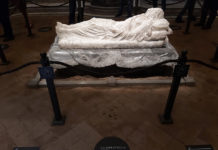Luisa Sanfelice, whose Alexandre Dumas devoted one of his novels “Neapolitan”, and the unknown Serafina Vargas, will be the “protagonists” of “The Republic of Utopia” free show (but with reservations required number 339.6235295), which will staged tomorrow, Friday, November 20, to 20, in the spaces of the Archivio Storico Banco di Napoli, in via Tribunali 213. In the heart of the historic center of Naples.
To animate the piece, set in the ad-hoc exhibition “Scenes from the Archives”, co-produced by the Fondazione Banco di Napoli, two love stories that intertwine with the tragic events of the Republic in 1799. A dialogue impossible where two women claim their right to build an ideal state, based on the happiness of the body. For the occasion, Lisette and Serafina tell, in their own way, Utopia, the great protagonist of the eighteenth century Neapolitan. The city, in this century, is the subject of an actual write action of the territory and of life through the great works of Bourbon as the Hotel of the Poor, a veritable city within a city, the factory of San Leucio silk before industry Southern Italy, even through the prisons. During the five months of the Republic the great utopia is to reinvent the city by changing its laws, the lifestyle, even the place names on the basis of the ideals of the French Revolution, in order to make a place to cultivate the dream, or if we want the illusion of happiness on earth.
“The Republic of Utopia” is a brand new production, the result of research work on valuable archival sources kept in the Archives directed by Eduardo Nappi, conducted by the cooperative En Kai Pan, while the Theatrical Association Aisthesis and its director Luca Gatta is also artistic director of the festival, they have dealt with the training of the actors through the international laboratory of scenic composition “Licos”.
Next meeting, on 17 and 18 December, again at 20, with “Comedy in time of plague”.

 Italiano
Italiano














